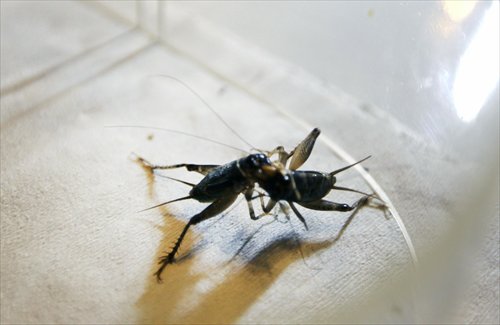
Every fall means cricket season for residents in the town of Dezhou, located in Eastern China's Shandong Province. In August, the local farmers catch the agile insects and sell them to cricket fighting hobbyists, which in turn generates 1 billion yuan annually.
The ancient past time of cricket fighting has been making a comeback in recent years and thrives in provinces like Jiangsu, Zhejiang, and Anhui.
In Shanghai, there are 100,000 cricket fighting connoisseurs. The demographic spends over 1 billion yuan annually on supplies like ceramic water feeders or mini bamboo buckets.
Enthusiasm for the game has even pushed up the price of cricket jars as an investment similar to antique vases and paintings.
Recently, at an art auction in 2004 in Xiamen, Fujian Province, a blue-and-white Ming porcelain cricket pot fetched 2 million yuan.
Today's Story in the Story looks at cricket fighting, an ancient Chinese custom that pairs humans with nature in a uniquely competitive fashion.

Owners use straw to stir crickets up before they fight. (Photo: Global Times)
Before Purple Golden Wing jumps into the arena for his once-in-a-lifetime fight, he will spend a month following a strict diet.
According to his trainer, for the insect gladiator to be "fully charged" it will switch from eating corn, wheat, and rice to carnivorous fares like shrimp, goat liver and snake meat.
Purple Golden Wing is a cricket and the most aggressive among the six common types. For the past two months, he and another 100 or so crickets have been carefully looked after by retired property manager Gu Haifang in a corner of his cramped Shanghai apartment.
The specimen is one of a few selected from a hundred contenders found in the fields of Henan Province by the 63-year-old cricket master.
Gu spends at least 10,000 yuan annually on his hobby, plus five hours every day feeding, bathing, and examining the agile insects.
At flower and bird markets, the crickets are priced between 10 to thousands of yuan each.

Two of the combatants get to grips with each other. (Photo: Global Times)
"Four to five hundred crickets can be sold in a day," said Liu Hang, a stall-owner at Wanshang Flower and Bird Market. "Business has been going up every year and buyers are very generous with these small creatures, although they live only three months," he added.
Liu said his specimens mostly come from Shandong Province, where the environment breeds a particularly aggressive type.
The crickets are often disposed of or set free after the fighting season ends in late November.
"It's a game every boy grows up within Shanghai, like the Barbie dolls for girls. Rich or poor, you can always enjoy it," said He Wen, a 39-year-old Shanghai native who founded China's first cricket fighting website.
"You can either catch a cricket from your backyard or squander tens of thousands of yuan on a breed believed to be invincible. But they do not necessarily win," He said.
The younger generations born in the 70s and '80s are more than eager to spend money, though less acquainted with the pastime than older practitioners. He spends 50,000 yuan every year on his hobby and has also invested 100,000 yuan in the website since it was founded 15 years ago.
Veteran players like Gu prefer to venture to remote parts of the country, sleeping by day and catching crickets at night.
"In the past, an average cricket could fight for at least seven rounds, but now three rounds are enough to exhaust most contenders," he said.
Contests range from one-on-one street fights to official tournaments, especially after the autumn equinox, a time when crickets have stored the most energy and are strong enough to fight.
In September, the Jiuxing Cup attracted more than 100 contenders and hundreds of spectators. This year's winner took home 12,000 yuan.
"Our bottom line is no gambling allowed. If there is anything we don't want to pass on from our ancestors about the game, it's the gambling aspect," said Gu.
(Produced by Nancy Xu Yan, Lance Crayon, Brian Lowe and Grace Xinyi Song. Music by: bensound.com. Text from Global Times and China Daily)


